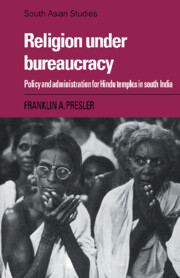Book contents
- Frontmatter
- Contents
- Dedication
- Preface
- Notes on sources, abbreviations and transliteration
- Map
- 1 Introduction: studying religion-state relations
- 2 The temple connection in the nineteenth century
- 3 Governance: the necessity for order
- 4 Governance: trustees and the courts
- 5 Economy: the problem of controlling land
- 6 Economy: the temple's weakness as landlord
- 7 Religion: purifying and organizing Hinduism
- 8 Religion: controlling the priesthood
- 9 Conclusion
- Bibliography
- Index
3 - Governance: the necessity for order
Published online by Cambridge University Press: 03 October 2009
- Frontmatter
- Contents
- Dedication
- Preface
- Notes on sources, abbreviations and transliteration
- Map
- 1 Introduction: studying religion-state relations
- 2 The temple connection in the nineteenth century
- 3 Governance: the necessity for order
- 4 Governance: trustees and the courts
- 5 Economy: the problem of controlling land
- 6 Economy: the temple's weakness as landlord
- 7 Religion: purifying and organizing Hinduism
- 8 Religion: controlling the priesthood
- 9 Conclusion
- Bibliography
- Index
Summary
In the HRCE, and among educated south Indians more generally, there is an image of temples as poorly organized, badly governed and corrupt. Temples are regarded as a “problem,” a continuing scandal. The atmosphere in many temples does not help this image. To their critics, temples seem noisy, chaotic and full of extraneous activity which disrupts quiet worship. According to the standard view, the reason for this state of affairs is not hard to find. The immense resources of temples are constantly exploited for personal gain – by temple functionaries and trustees, by contractors, merchants, politicians and others pursuing status, honor and profit. According to this view, the solution to the problem is also clear. Corruption and mismanagement need to be brought under control, the perpetrators ousted and prosecuted, and the temples reorganized for the benefit of devout Hindu worshippers.
This image is not especially new. It was in fact substantially the same in the nineteenth century, and led directly to state intervention. Without vigilant state protection, it was argued, temples inevitably decline, preyed upon by those who manage to get a hold over them. This was the central argument used in the 1920s to justify setting up the HRE Board, an argument affirmed many times since. The state must gain control and reorganize the temples, so that temples can fulfill their religious mission.
Governance was thus uppermost when the HRE Board began its work. However, after over a half century of administration by the HRE Board and its successor, the HRCE, the problems remain substantially the same.
- Type
- Chapter
- Information
- Religion under BureaucracyPolicy and Administration for Hindu Temples in South India, pp. 36 - 56Publisher: Cambridge University PressPrint publication year: 1988



